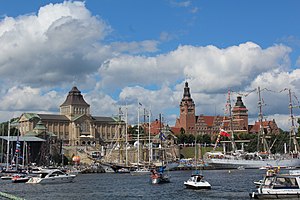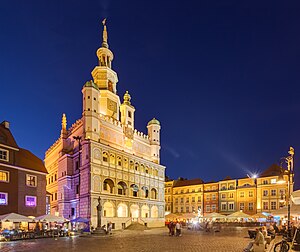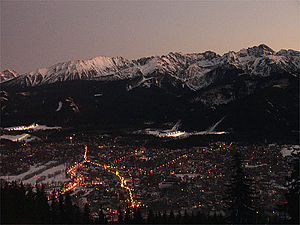Tourism in Poland
| Tourism in Poland | |
|---|---|
| Poland's top ten urban destinations Old Town Market Square, UNESCO World Heritage Site | |
 | |
 | |
 | |
 | |
 | |
 Wrocław Zoo attracts 1.8 million visitors annually.[2] | |
 | |
 restored to its former glory restored to its former glory |
Overview
In the 21st century, Poland is one of the safest countries in Europe,[5] frequently visited by tourists.
Poland, especially after joining the European Union in 2004 and acceding to the Schengen Agreement in 2007, became a place frequently visited by tourists. Most tourist attractions in Poland are connected with natural environment, historic sites and cultural events.
According to Tourist Institute's data, Poland was visited by 15.7 million tourists in 2006, and by 15 million tourists in 2007,
History
The first Polish tourists were
After
After the
Natural environment
Poland has a diversified natural environment, which is relatively unaffected by human development. There are 23
Popular tourist destinations
- The Royal Road of Kraków
- Tourist attractions in Warsaw
- Wrocław Zoo (most frequently visited attraction in Poland[9])
- Hunting on the Wrocław's dwarfs
- Centennial Hall, Wrocław Opera[10]
- Old Town in Gdańsk
- Modernist Center of Gdynia
- The Royal-Imperial Route in Poznań
- Jewish Heritage Trail in Bialystok
- European Route of Brick Gothic
- Białowieża National Park
- Dunajec River Gorge
- Tatra Mountains
- Karkonosze Mountains
- Kraków Old Town
- Auschwitz-Birkenau State Museum
- Krasiński Palace
- 13th century Wieliczka Salt Mine
- Medieval Town of Toruń
- Old City of Zamość
- Wilanów Palace
- Jasna Góra Monastery in Częstochowa
- Cistercian Lubiąż Abbey
- Cistercian Krzeszów Abbey
- Royal Gniezno Cathedral
- Wooden Churches of Southern Little Poland
- Wooden Churches of Peace in Jawor and Świdnica
- Sanctuary in Kalwaria Zebrzydowska
- Poznań Old Town and its Ostrów Tumski, Poznań
- Mount Ślęża in the Sudetes
- Kłodzko Fortress complex
- Pszczyna Palace
- Augustów Canal with sluices
- Benedictine Abbey in Tyniec
- Muskau Park shared with Germany
- Palace on the Isle
- Frombork Cathedral
- Łańcut Palace
- Kozłówka Palace
- Historic town of Sandomierz
- Kazimierz Dolny
- National Museum in Warsaw
- Seaside resort of Sopot
- Branicki Palace
- Historic town of Kłodzko
- Elbląg Canal
- Spa town of Kudowa-Zdrój
- Palace of the Kraków Bishops in Kielce
- Historic town of Wadowice
- Czartoryski Museum
- National Museum in Wrocław
- National Museum in Poznań
- Święta Lipka Basilica
- Historical town of Przemyśl
- Seaside resort of Kołobrzeg
- Juliusz Słowacki Theatre
- Ląd Abbey
- Historic town of Jelenia Góra
- Zakopane; known as "the winter capital of Poland"
- Spa town of Karpacz
- Royal Baths Park
- Collegiate Church of St. Mary and St. Alexiusin Tum
- Pławniowice Palace
- Project Riese
- Wolf's Lair
Castles
- Wawel Royal Castle
- Royal Castle in Warsaw
- Niedzica Castle
- Malbork Castle
- Baranów Sandomierski Castle
- Książ Castle
- Nowy Wiśnicz Castle
- Czocha Castle
- Moszna Castle
- Ujazdowski Castle
- Imperial Castle, Poznań
- Grodziec Castle
- Krasiczyn Castle
- Pieskowa Skała
- Lidzbark Warmiński Castle
- Kwidzyn Castle
- Gołuchów Castle
- Kliczków Castle
- Golub-Dobrzyń Castle
- Krzyżtopór
- Ogrodzieniec Castle
- Rzeszów Castle
- Dunajec river castles
- Chojnik Castle
- Kórnik Castle
- Bobolice Castle
- Będzin Castle
- Pomeranian Dukes' Castle, Szczecin
- Bytów Castle
- Tenczyn Castle
- Bolków Castle
- Czersk Castle
- Ciechanów Castle
- Lublin Castle
- Uniejów Castle
- Darłowo Castle
- Bielsko-Biała Museum and Castle
- Sanok Castle
- Dzików Castle
Cultural events
Tourist resorts
There are dozens of sea resorts on the coast of
In the vicinity of Low Beskids lies a tourist resort that offers a blend of mountainous terrain and an aqueous environment, with Lake Rożnów in the centre.
Christian pilgrimage
It's estimated that 13% (of the 1.8 million in 2005) of visitors of the Basilica of Our Lady of Licheń arrive from abroad.[13] Jasna Góra Monastery was visited by 3.6 million of pilgrims from 78 countries in 2014.[14]
Transport in Poland
Tourist infrastructure and facilities are abundant, especially in larger cities and in major tourist resorts. In large Polish cities, urban public transport is very well developed.
The biggest cities (Kraków, Wrocław, Poznań, Gdańsk and Szczecin) have international airports with connections with many European cities and with the Frédéric Chopin International Airport in Warsaw, which is the main hub of LOT Polish Airlines.
Intercity connections are offered by
Connections by ferry to Sweden and Denmark through the Baltic Sea are for example from Gdańsk, Gdynia and Świnoujście (inter alia Polferries).
See also
- Polish Tourist and Sightseeing Society (Polish: Polskie Towarzystwo Turystyczno-Krajoznawcze – PTTK)
- Mountain Volunteer Search and Rescue (Polish: Górskie Ochotnicze Pogotowie Ratunkowe – GOPR)
- Tatra Volunteer Search and Rescue (Polish: Tatrzańskie Ochotnicze Pogotowie Ratunkowe – TOPR)
- Crown of Polish Mountains
- List of spa towns in Poland
References
- ^ a b c d e f g h i j TripAdvisor. "Top 10 Destinations – Poland". Travelers' Choice 2013 (Winners). TripAdvisor.ca The world largest travel site. pp. 1 of 10. Retrieved 20 December 2014.
Travelers' Choice 2014 Update: 1.Krakow, 2.Warsaw, 3.Wroclaw, 4.Poznan, 5.Bialystok, 6.Sopot, 7.Zakopane, 8.Lodz, 9.Szczecin, 10.Gdynia.
{{cite web}}: External link in|quote= - ^ "Afrykarium odwiedziło 5 mln osób". Retrieved 1 February 2019.
- ^ a b c d The Touropia Team (2013). "10 Top Tourist Attractions in Poland". Touropia "best of" lists. Touropia. Retrieved 26 November 2013.
- ^ a b Touristrack. "10 Famous Tourist Attractions in Poland You Must Visit". Central Europe. TourisTrack.com. Retrieved 26 November 2013.
- ^ Polska jednym z najbezpieczniejszych krajów w Europie
- ^ Information about tourism in Poland (in Polish). Archived 16 April 2013 at archive.today Source: Instytut Turystyki, 2008.
- ^ GUS (2008). "Przyjazdy do Polski (Foreign visits to Poland)". Statistics (in Polish). Instytut Turystyki. Archived from the original on 25 December 2012. Retrieved 31 December 2012.
- ^ Katarzyna Sobierajska, Ministry of Tourism (2012). "Pierwsze efekty Euro 2012. Resort turystyki przewiduje wzrost liczby turystów w 2013 r. nawet o pół miliona". Live interview (in Polish). Agencja Informacyjna Newseria. Retrieved 31 December 2012.
- ^ Zoo Wrocław – lepsze od Wawelu i Wieliczki
- ^ Narodowy Instytut Dziedzictwa, "Wrocław – zespół historycznego centrum." (in Polish)
- ^ "Festiwal Polskiego Malarstwa Współczesnego". ZPAP Szczecin.
- ^ "ABOUT THE FESTIVAL". Retrieved 14 September 2019.
- ^ "E-mail z Lichenia: Zagraniczni pielgrzymi".
- ^ "Biuro Prasowe Jasnej Góry - Jasnogórskie Sanktuarium w Roku 2014".
Further reading
- Kaszynski, Tadeusz, Through Europe to Poland by Car, 1st and rev. ed., New York City, 1968




